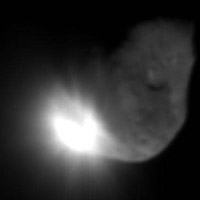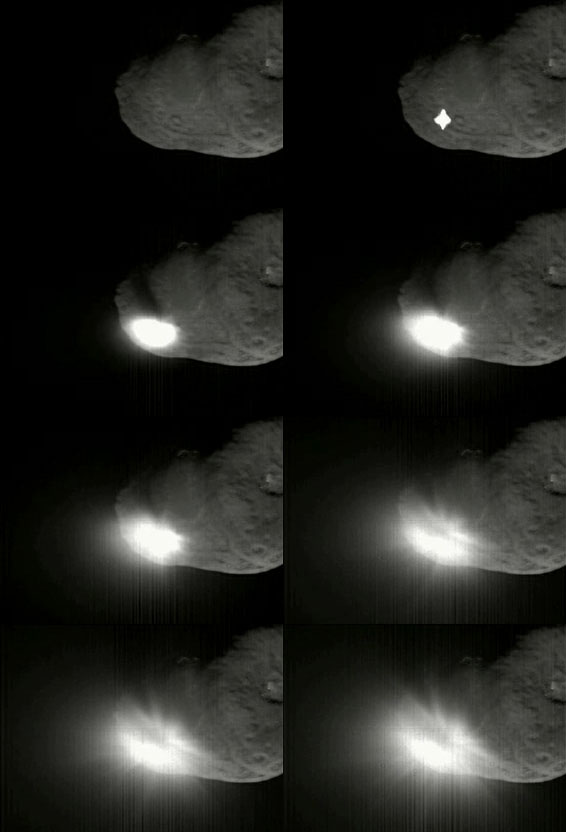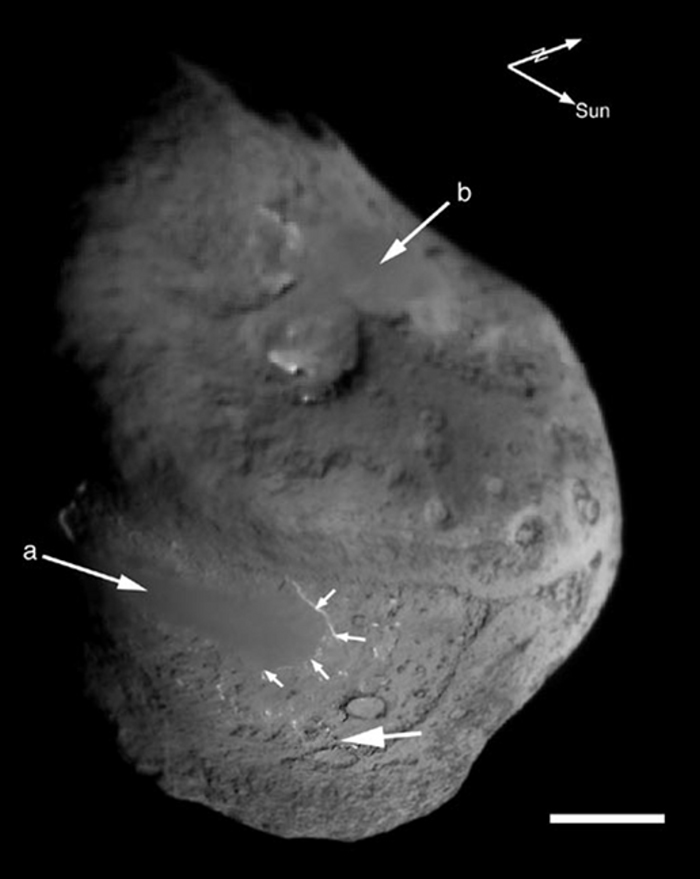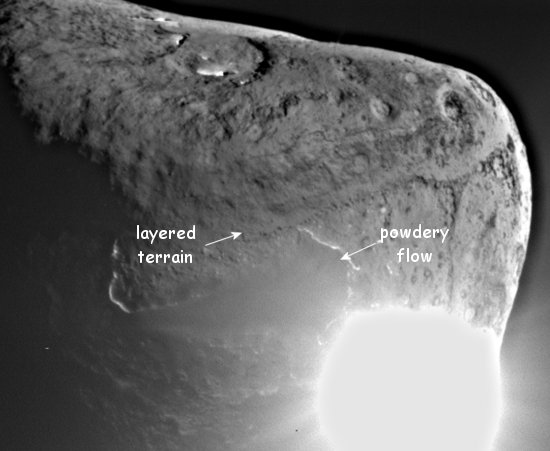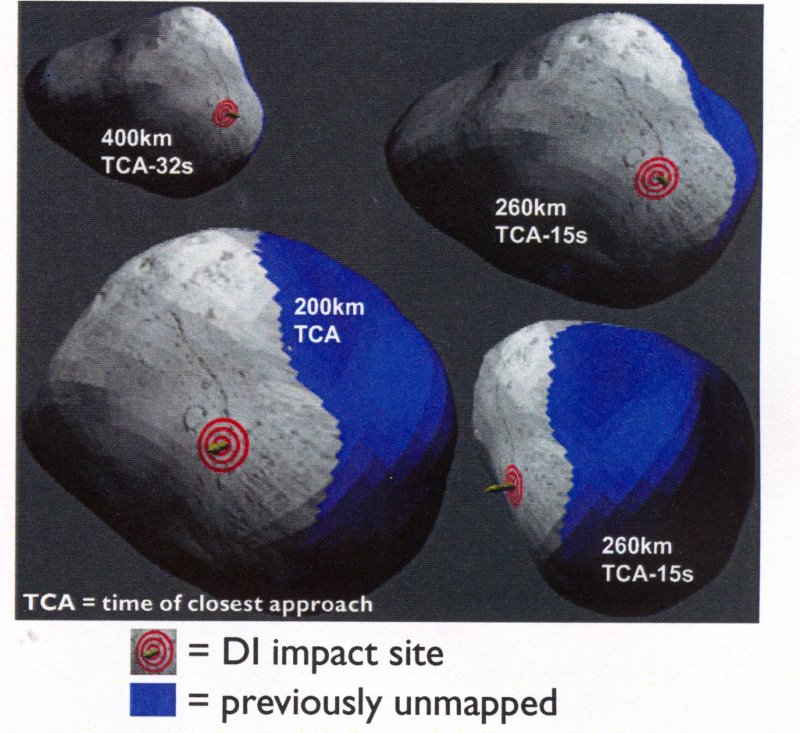| DANGERS
FROM SPACE
NASA Deliberately Crashing Satellites |
||||||||||||
|
.
NASA Probe Strikes Comet Tempel
1
Excerpts: US space agency (Nasa) scientists are celebrating after seeing a probe crash into the heart of a comet. The washing machine-sized "impactor" collided with Comet Tempel 1 at a relative speed of 37,000km/h, throwing up a huge plume of icy debris... "We hit it just exactly where we wanted to," said an ecstatic Dr Don Yeomans, a Nasa mission scientist... "The impact was bigger than I expected, and bigger than most of us expected. We've got all the data we could possibly ask for." ... Agency staff working on the $333 Million mission cheered, clapped and hugged when the first pictures of the impact came through to the control room at Nasa's Jet Propulsion Laboratory (JPL) in California... Two stages: Preliminary data indicated two successive flashes. "What you see is something really surprising. First, there is a small flash, then there's a delay, then there's a big flash and the whole thing breaks loose. We may have been able to detect some structural response to the impact," mission co-investigator Pete Shultz said.... Comments:
|
||||||||||||
|
||||||||||||
|
..
Monday, July 4, 2005 Comet Tempel 1 looks like a lumpy potato covered with craters, the first close-up images from NASA's Deep Impact mission suggest. The space agency successfully smashed into the comet early Monday in the hopes of examining its frozen core for ice and rock left over from the early solar system. When the washing machine-sized probe, or "impactor," had its rendezvous with the comet, the collision set off a brighter than expected burst of light in the sky about 130 million kilometres from Earth. Comments:
|
||||||||||||
Satellite Comet Crash and the True Nature of the Solar System NASA got the brilliant idea of sending a spacecraft to an incoming comet, crashing a probe the size of a truck into the comet and then photographing the result. The result expected was, the probe would produce a crater on the comet. The depth of the crater would help determine what the comet's composition was. Of course, empirical science already knows what a comet is made up of: dirt, ice, and other debris left over from the formation of the solar system. NASA expected a whole bunch of this debris to shoot out of the hole, forming a trail that could be analyzed. The JPL course correction team was right on target and on July 3, 2005, the Deep Impact probe did indeed impact with comet Tempel 1. How deep the impact was, however, will never be known because instead of a cloud of five billion old debris shooting up and forming a cometary tail, the impact produced one heck of an explosion, one anyone can see by viewing NASA's film, Tempel Fades Into Night, at http://www.nasa.gov/mission_pages/deepimpact/main/ The standard comment by empirical science, after showing pictures of the course correction team jumping up and down in glee in the control room worldwide, was, well, it's going to take awhile to digest the results. What this means is, it's going to take awhile to come up with some sort of ridiculous explanation why a giant snowball acted like an atomic bomb when it was hit by a probe ( it didn't take long, after all, they stuck to the script - see the end of the column). The reason empirical science knows that comets are giant snowballs, of course, even though pictures of them taken by flybys clearly show they are made of something pretty substantial and definitely in the category of rock, is, you guessed it, empirical science's God, Sir Isaac Newton. At the risk of repeating myself for the hundredth time, Newton set out to prove that gravity was proportional to and a property of matter by assuming that all matter was made up of uniform particles. He used this assumption to predict the course of planets. When the math didn't work, and a hundred years later when the new mathematical science realized it didn't work big time for the planets, it simply said, Newton was right, he just forgot about density. So, instead of using the amount of matter in the planets to prove that gravity was a property of and proportional to the matter that made up the planets to demonstrate the course of the planets, it just said, it's a true statement, a law of the universe, and therefore we have to use the course of the planets to determine the amount of matter that makes them up. Assuming the unproven concept and applying it to the motion of the moon, science concluded the backside of the moon was caved in or the moon was filled with caves. It then went on to compute the matter in the Earth, Mars and Jupiter and found that Jupiter didn't have any matter at all, it must be a gas planet, the same gas that spewed up billions of tons of dirt and rock with each of the serial impacts of comet Shoemaker-Levy. Which brings us to comets again. Comets are made up of ice, and after Shoemaker-Levy, very dirty ice, maybe even ice with a rock-like crust, simply because computing their orbits determines the matter that makes them up. The origin of comets is empirically fantasized as being something called the Kuiper Belt, a region beyond Neptune, for regulars and the Ort Cloud for irregulars, a cloud of icy-like particles that surrounds the solar system beyond Pluto. Which brings us to the solar system. Empirical science, believing that the universe is founded on laws empirical scientists uncover, remains static regardless of additional discoveries. Aristotle put the Earth at the center of the universe, Copernicus put the sun at the center of the solar system, and before we even knew there were galaxies, Newton put Celestial Mechanics in place, the absurd notion that the only force in the universe is gravity and all other motion is the result of historical motion. Making the solar system operate on the basis of historical motion, Newton at least concluded that God came back every once in awhile to give the motion a little boost. However, when empirical science eliminated God from the equation, historical force became just that, a force that goes on forever unchanged. This means that nothing has changed since the solar system formed. Thus, Celestial Mechanics had to be falsified to explain the periodic appearance of comets. This was done first by having Jupiter's orbit periodically knock bits of matter out of the Kuiper Belt to create the comets that then return on a regular basis until they break up and then it was more sophisticatedly done, and sophisticated in empirical science means making up unverifiable crap that can then claimed to have been found by the select few with access to the billion dollar equipment science extorts from us, irregular comets, those that don't adhere to Newton's dictates, empirical science claimed came from the Ort Cloud which was beyond the orbit of Pluto whose orbit, by the way, astronomers can't even calculate. The movement of the giant gas planets, the gas created by reversing Newton's failed attempt to prove gravity is a property of matter, periodically knocks chunks of ice out of the Kuiper Belt which then travel toward the sun. As they get closer to the sun, they begin to melt, giving off their icy gases, and the reflection of the sun off these icy gases trailing behind the comet (in frictionless space, by the way) are what produces the comet's tail. The NASA Deep Impact was expected to produce a cometary tail but all it did was create one heck of an explosion. Why? To start with, the solar system is not static, like gravity is not static. The solar system is dynamic, responding to current forces acting on the planets. See column 20-05. But more to the point, the solar system is moving in space, all of the matter that makes it up following the sun's field of attraction as it slowly rotates as the galaxy of which it is a part rotates. Most astronomers today will admit to the fact that the sun is rotating with the galaxy, but the nitwit big bangers, who have the universe expanding, would claim the sun is also moving at almost half a million miles an hour along with the expansion although I've heard rumors that the big bang is not measurably locally, fancy that. Let's look at how the Earth behaves as it moves around the sun. The Earth orbits the sun in a year. It reaches its closest point to the sun in December at the winter solstice. It reaches its furthest point from the sun in summer at the summer solstice. Thus its orbit is slightly oblong. This would suggest right off the bat the sun was dragging the Earth as well as everything else it contains, behind it, and in fact, I compute the speed of the sun with a simple mathematical formula that uses the distance the sun travels between these two points and the time it takes for it to do so. See http://www.copernican-series.com/index2.html, click on consequences, if you are mathematically inclined. Computing the speed and direction of the sun, of course, was the purpose of Michelson and Morley's ill conceived and spectacularly failed experiment that led to the notion that mass increased with speed, that space and time were not only physical, but connected, quantum mechanics or science as they say today for the source of light and all the rest of the 20th Century's jokes of empirical science. Column 02-04 describes the mistake at the basis of the entire edifice of the astronomical error concerning the solar system and to demonstrate how empirical science carries its mistakes forward to the end of time, Brahe, the author of the mistake, made the mistake because he believed the Earth was at the center of the universe, his devious acolyte Kepler incorporated the mistake into the laws of the universe he supposedly uncovered, and Newton used those laws, with the mistake incorporated into them, to produce the Celestial Mechanics which controls astronomical thought completely. Basically, the mistake occurred because Brahe measured the moon speeding up in the summer and slowing down in the winter. Because he was convinced the Earth was stationary, he interpreted the change in motion to the moon, that is was actually speeding up and slowing down. Kepler computed the same effect for the orbit of Mars, and we can compute the difference easily for Earth by buying a Farmer's Almanac, which lists the times between the summer and winter solstices. However, the moon and the planets are not speeding up and slowing down, a simple impossibility, the sun is moving and as it moves, it shortens the distance its parts, the matter it is carrying along with it, travel from the winter to the summer solstice by the distance it has moved forward. However, when the matter traveling with it has to move from the summer to the winter solstice, it has to travel further, the distance the sun has moved during the period. This is why I was able to compute both the direction the sun was moving and the speed at which it was moving. The planets are not speeding up or slowing down, they are moving at a uniform rate with the time differential being a product of distance rather than rate. So with the sun moving through space at slightly over 312 miles per hour, it is not only going to be incapable of carrying along a bunch of ice particles, it is actually going to encounter objects in space, formed in the absence of a field. As described in columns 18 & 19-05, matter that forms in the absence of a field is matter made up of atoms with the highest number of units in their nuclei. For example, uranium is unstable on the Earth because the Earth is positioned a certain distance from the sun and is a certain temperature, the two fields combining to produce a field in which uranium, when it's removed from the pitchblende that stabilizes it, begins to decay, come apart, form into elements with lesser units in the nuclei, elements that will be stable in the field. Uranium simply couldn't exist on Mercury because the field is too strong. However, it would be stable on Pluto because the field is considerably weaker than the field at the Earth's surface. Field replacement (column 08-05) shows that the number of units that can exist without combustion in the center of an atom is inversely proportional to the strength of the field in which the atom exists. Iron is stable on Earth but would be unstable on Mercury. The elements we create in the laboratory that exist for only a moment will be stable on Pluto, and there may be elements far beyond our ability to produce that, on Pluto, are unstable just as uranium is unstable on Earth. Thus, as the sun moves in its path around the galaxy, it is going to occasionally encounter chunks of matter that were formed in the absence of a field. Some of these chunks will pass by, never to be seen again. Others will be captured into orbits around the sun. All of them will be made up of atoms with the highest number of units that can exist in an atom's nucleus, matter that was formed in the absence of a field. As the chunks of matter approach the sun, they are moving deeper into a field and when the get close enough, the atoms that make them up begin to be field replaced. In short, they ignite and the comet lights up. As the comet gets closer to the sun, and thus into a stronger field, the combustion process starts erupting from it, producing the comets tail. The fact that the tail always points away from the sun no matter in which direction the comet is moving puts the quits to Celestial Mechanics, which requires the planets to move frictionlessly in empty space. Space is not empty. It is filled, at least around a star, with the star, our sun's, emission field and it is that emissions field that is pushing the fire from the comet away. Thus, when Deep Impact hit Tempel I, it was not hitting ice or dirt or rock. It was hitting the most complex atoms that exist in the universe. There was no need for the compression necessary to explode uranium or plutonium in bombs on Earth because the atoms were ready to explode. They did and the movie shows the result, one gigantic explosion. NOTE: It didn't take long for the empirical wizards to spin their cotton candy. What we clearly see as an explosion (as long as NASA allows it to remain on their site) is a giant plume of gas and dust far richer than expected in carbon compounds. Now how is that for redirecting the argument. These carbon compounds reinforce the view that comets contributed to the raw materials of the accidental life on Earth. Not only is empirical science redirecting the argument, it is doing anything it can to hide its ignorance about the real source of life. Then the spin goes, the impact threw about 5,500 tons of water into space. Let me ask, did they bottle it? Of course not, they couldn't even measure something like this. It's a trash statement. These nitwits go on to say the density of the comet is very low and the porosity is very high, the texture crumbly, the impactor plowed to a depth of tens of meters (but could not be more specific because of the plume of powder ice and dust (does that look like a plume of ice and dust to you?) and the plume was so thick the crater could not be viewed. Now listen to this bit of garbage. They think that 75 to 80 percent of the comet is empty space. But I got to hand it to them for brutal honesty. The press release admitted that the presence of craters on the surface of Tempel 1, craters that looked just like the craters on the moon, were puzzling. Don't worry folks, we'll soon learn those craters are ice boils that mimic craters. Empirical science is really a gag, and if it didn't involve the nature of the technology that might ensure the survival of the species, it would be something to laugh endlessly about. POSTSCRIPT:
UPDATE:
Peter Bros is the author of the 9 volume Copernican Series and is President of The Far Museum of Dallas, an actual history museum, which will house its collection of 50,000 rare Eastern Mediterranean manuscripts and artifacts together with actual history displays and tours in a full-sized replica of the Egyptian Temple at Dendera to be built in the Dallas Ft. Worth area. Email:peterbros@therealskeptic.com Related Websites:
|
||||||||||||
|
Deep Impact is a smashing success BY WILLIAM HARWOOD
PASADENA, Calif. (CBS) - A scientific smart bomb crashed into Comet Tempel 1 early today, blasting a sparkling shower of icy debris into space in a 23,000-mph Fourth of July spectacular 83 million miles from Earth. "Jeez, and we thought it was going to be subtle!" marveled comet expert Donald Yeomans as images of the impact were received at the Jet Propulsion Laboratory. "We've had a far bigger explosion than we anticipated. ... I can't imagine how this could go any better." Said Rick Grammier, the Deep Impact project manager: "It came together quite well, just phenomenal. It went very much like clockwork. We didn't exercise a single contingency plan." As it closed in on Tempel 1 at 11 times the speed of a rifle bullet, the impactor beamed back a stream of ever more detailed pictures, showing circular craters, plain-like areas, a long, snaking ridge and jumbled-looking terrain similar to regions on the moon. "It's illuminating some extremely interesting surface features," Yeomans said, describing the pictures as they as they came in. "That's going to keep the scientists going for a long time. The navigation was perfect, it couldn't have been any better. The impact was bigger than I expected, bigger than most of us expected. So this is going to tell us a great deal about how this comet is put together." SOURCE: Space Flight Now |
||||||||||||
|
Bull's-Eye! Deep Impact Scores A Direct Hit ..
by Kate Melville Mission accomplished! Deep Impact's intercept with comet Tempel 1 has proceeded without a hitch, with NASA's ground control personnel seen cheering, back slapping, high-fiving, and hollering: "That's awesome!" and "My God!" soon after the impactor's direct hit with the comet was confirmed. "The impact was perfect", said Dr. Mike A'Hearn, the mission's team leader. SOURCE: Science A Gogo |
||||||||||||
|
Pasadena CA (AFP) Jul 04, 2005 Scientists said preliminary data showed that the impact provoked two successive flashes, which could mean the comet's surface and depth are composed of two different matters. "What you see is something really surprising. First, there is a small flash, then there's a delay, then there's a big flash and the whole thing breaks loose. We may have been able to detect some structural response to the impact," mission co-investigator Pete Shultz, of Brown University. One image shows a "self-luminous" and "extremely bright incandescent ball," he said in a news conference at NASA's Jet Propulsion Laboratory in Pasadena, California. Scientists say the comets circling the sun, which number in the billions, are leftovers from a massive cloud of gas and dust that condensed to form the Sun and planets about 4.6 billion years ago. Their geological and chemical structures could thus contain important clues to the nature of the Universe and how it was formed, including Earth. The projectile was fired from a mothership spacecraft, "Deep Impact," that was itself launched from the Kennedy Space Center in Florida in January for the 173-day, 431-million-kilometer journey. The impact gouged a football stadium-sized crater on the surface of the comet, sending up a cloud of ice, dust and debris that researchers hope will offer several years' worth of valuable scientific data. On Saturday, Tempel 1 belched out ice and dust, expanding the size of the cloud around it. The outburst, the fourth in the past three weeks, was not of particular concern to National Aeronautics and Space Administration scientists, Grammier said before the impact. "The comet is definitely full of surprises so far and probably has a few more in store for us," he said. |
||||||||||||
|
Comet Tempel 1's Electrifying Impact The Electric Universe
News Item
Excerpt:
Excerpt:
|
||||||||||||
|
Hubble Telescope Views Explosion From Earth .
July 18, 2005
Deep Impact on Comet Tempel 1
from Hubble
Explanation: It was a human-made event visible across the Solar System. At the direction of terrestrial scientists, a refrigerator-sized probe from the Deep Impact mission struck Comet Tempel 1 on July 4 at over 35,000 kilometers per hour. The unexpectedly bright explosion was not nuclear but rather originated from a large plume that reflected back sunlight. Pictured above is how the event looked to the Earth-orbiting Hubble Space Telescope. A large cloud of bright material is seen emanating from the comet's nucleus and then dispersing. The area encompassing the comet became over two times brighter in the hours after the impact. Astronomers will continue to study the images and data returned by Deep Impact to better determine the nature of Comet Tempel 1 and discern clues about the formation dynamics of the early Solar System. SOURCE: NASA APOD |
||||||||||||
|
.
November 02, 2006 Arrows a and b point to large, smooth regions. The impact site is indicated by the third large arrow. Small grouped arrows highlight a scarp (a cliff or steep slope along the edge of a plateau) that is bright due to illumination angle. They show a smooth area to be elevated above the extremely rough terrain. The white scale bar in the lower right represents 1 km across the surface of the comet nucleus. The two directional arrows (vectors) in the upper right point to the Sun and Celestial North. |
||||||||||||
|
Blowing a Hole in a Comet: Take 2 .
Sept. 26, 2007 The flash! The dazzle! The front page of the New York Times! Two years ago, NASA's Deep Impact spacecraft dropped an 820 lb copper projectile onto Comet Tempel 1, unleashing an explosion that made headlines around the world. Exploding comets tend to have that effect. But how many people know what happened after the blast? The surprising answer is none--not even NASA. Deep Impact's prime mission was to punch a hole in Tempel 1 and look inside, giving researchers their first glimpse of a comet's internal structure. But "we were never able to see the crater because the cloud of debris was so thick," says Michael New of NASA Headquarters. Why didn't Deep Impact wait until the dust cleared? It couldn't. The mission was designed from the beginning as a high-speed flyby, giving extra velocity to the "bullet." Orbiting was not an option. Carried by its own momentum, Deep Impact sailed away before the cloud had time to dissipate. Take 2: NASA is going back for a second look. "We're sending another spacecraft back to Tempel 1, the Stardust probe," says New. Stardust is famous for its January 2004 flyby of Comet Wild 2. Severely buffeted by jets of gas and debris flowing from the comet, Stardust nevertheless managed to snatch thousands of samples of comet dust and return them to Earth for analysis. "Stardust is one of the great successes of NASA's Discovery program," says New. (The Discovery program launches innovative, inexpensive spacecraft every 18-to-24 months on cutting edge missions. Deep Impact is also part of this program.) At first, Stardust was simply retired, sailing the void with nothing to do—but now it is being recycled as "Stardust-NExT," short for New Exploration of Tempel 1. Planetary science professor Joe Veverka of Cornell University is the mission's principal investigator. "We're very excited to go back," says Veverka. "Stardust is due to reach Comet Tempel 1 in 2011. By then the debris cloud will be long gone and we should get a clear view of the crater." Peering into the crater, however, "is only half the story," says Veverka. Before the cloud spoiled the view, Deep Impact's cameras recorded some surprising things:
For one, the comet is ringed by a strangely-layered "sedimentary" terrain. There are no rivers on comets, so what causes these features? "Good question," says Veverka. One possibility: comets might be formed in layers. "Imagine two small proto-comets smashing into one another, sticking together and flattening like pieces of playdough," he says. Or maybe the layers are created via some form of hot erosion when the comet swings past the sun every 6.5 years. "We just don't know." Stardust will gather important clues. "We're returning to the comet almost exactly one orbit--that is, one comet-year--after the first visit. This gives us a chance to see how solar heating might have altered Tempel 1's face." Another surprise was landslides. "Deep Impact saw an enormous flow of smooth, powdery material" completely covering about a kilometer of underlying terrain, says Veverka. This feature is as mysterious as the layers, but it could explain one thing: why Deep Impact's debris cloud was so troublesome. "We might have hit a patch of deep powder," adds New. "Fine particles tend to make big clouds that are hard to see through." "This is why we explore," adds Veverka. "Tempel 1 is an amazing comet."
Veverka notes that recycling a mission like Stardust is cheaper than sending a whole new spacecraft. "Stardust-NExT costs less than 15% of a full-up Discovery mission." "Giving new assignments to veteran spacecraft represents not only creative thinking and planning, but also a prime example of getting more from the budget we have," agrees Alan Stern, associate administrator of NASA's Science Mission Directorate. Deep Impact is being recycled, too. "We're using Deep Impact for two new projects," explains New. One is called DIXI (Deep Impact Extended Investigation): "Deep Impact will fly by Comet Boethin in December 2008 for a close-up investigation of the comet's nucleus." The second is EPOCh (Extrasolar Planet Observation and Characterization): "Cameras on Deep Impact will target nearby stars with known giant planets. By watching these planets transit (pass in front of) their stars, Deep Impact will be able to determine whether they possess rings and/or moons." For this work, EPOCh's sensitivity will exceed that of existing ground and space-based observatories, possibly leading to the discovery of new Earth-sized planets. No crater? No problem. Says New: "You can't keep a good Discovery mission down." |
||||||||||||
| NASA to keep Deep Impact in
space
Jul 21, 2005, 1:09 GMT Washington - The U.S. space agency announced Wednesday that it plans to keep its "Deep Impact" craft in space. The move will allow the spacecraft to be used again, if it is feasible to do so. NASA said it would keep Deep Impact near Earth and a course adjustment will put the spacecraft into an orbit at the end of 2007. Deep Impact had delivered a probe into the path of a comet and recorded the resulting collision. NASA said that mission had exceeded all expectations. The space craft will not be used for a similar mission again because it only had one "impactor". Scientists hope to gain a better understanding of the creation of the universe from the Deep Impact mission. SOURCE: monstersandcritics "We're sending another spacecraft back to Tempel 1, the Stardust probe," says New. Stardust is famous for its January 2004 flyby of Comet Wild 2. Severely buffeted by jets of gas and debris flowing from the comet, Stardust nevertheless managed to snatch thousands of samples of comet dust and return them to Earth for analysis. "Stardust is one of the great successes of NASA's Discovery program," says New. (The Discovery program launches innovative, inexpensive spacecraft every 18-to-24 months on cutting edge missions. Deep Impact is also part of this program.) - SEE ABOVE So it would appear that these spacecraft are reusable and can be brought back to Earth orbit to 'park' them for future use... See STARDUST - The Discovery Program |
||||||||||||
| FAIR USE NOTICE: This page contains copyrighted material the use of which has not been specifically authorized by the copyright owner. Pegasus Research Consortium distributes this material without profit to those who have expressed a prior interest in receiving the included information for research and educational purposes. We believe this constitutes a fair use of any such copyrighted material as provided for in 17 U.S.C § 107. If you wish to use copyrighted material from this site for purposes of your own that go beyond fair use, you must obtain permission from the copyright owner. | ||||||||||||
|
|







